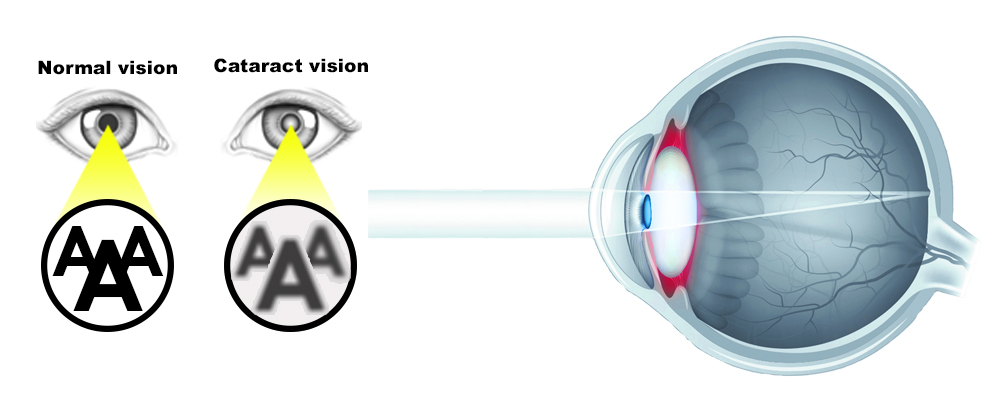
About Cataract
A cataract is a clouding of the natural lens in the eye that affects vision. The lens is a clear part of the eye that helps to focus light, or an image, on the retina. The retina is the light sensitive tissue at the back of the eye. In a normal eye, light passes through the transparent lens to the retina. Once it reaches the retina, light is changed into nerve signals that are sent to the brain. The lens must be clear for the retina to receive a sharp image. If the lens is cloudy from a cataract, the image will be blurred.
Symptoms of Cataract
People with cataract, even when wearing glasses, typically experience:
Types of Cataract
Treatment for Cataract
There are no medicines with proven efficacy to prevent or treat cataract. The only effective treatment for cataract involves surgery is to remove the cataract and replace it with an intraocular lens implant. It is the most common Modern Technique which is used for removal of cataract is known as Phaco / MICS. Cataract surgical procedure around the world and is considered to be extremely successful and safe. Diabetes, hypertension and other general health problems are not a contraindication for cataract surgery and the cataract need not ‘mature’ for surgery. A cataract needs to be removed when vision loss interferes with your everyday activities, such as driving, reading, or watching TV. You and your eye care professional can make this decision together. Sometimes a cataract should be removed even if it does not cause problems with your vision. For example, a cataract should be removed if it prevents examination or treatment of another eye problem, such as age related macular degeneration or diabetic retinopathy. If you have cataracts in both eyes that require surgery, the surgery will be performed on each eye at separate times. Many people who need cataract surgery also have other eye conditions, such as age related macular degeneration or glaucoma. If you have other eye conditions in addition to cataract, talk with your doctor. Learn about the risks, benefits, alternatives, and expected results of cataract surgery.
Types of cataract surgery
There are two types of cataract surgery. Your doctor can explain the differences and help determine which is better for you:
Advantages
Types of Lens Implants
When undergoing cataract surgery or refractive lens exchange, you have options when it comes to intraocular lenses (IOL). Below are the different types of IOLs that can be implanted during your surgery. Patients can choose the standard IOL or select from several “Lifestyle Lens” options.
Standard, Single Focus or Monofocal Lens
With basic cataract surgery, the cataract is removed and replaced with a standard, single focus IOL. This lens can correct for the impairment caused by the cataract but it will not ensure the patient’s independence on prescription glasses for other vision problems.
Toric Lens - Lifestyle Lens
With a toric IOL, patients are able to achieve the same results of basic cataract surgery, but will have the added benefit of vision correction. This specialized IOL has the ability to correct astigmatism (a condition in which the shape of the cornea is irregular, causing vision to degrade without the help of corrective eyewear). A toric lens can help to adjust the focus of light appropriately for individuals who have astigmatism.
Multifocal Lens - Lifestyle Lens
This type of lifestyle lens corrects the patient’s ability to see at a distance, and can provide an improved ability to adjust focus at near or intermediate distances. A multifocal IOL can virtually eliminate a dependence on glasses for most patients. Some patients may still use glasses to see very fine details up close. Due to the unique capabilities of this IOL, the patient may need to go through an adjustment period, similar to adjusting to a new pair of bifocals or progressive lenses.
Multifocal Toric Lens - Lifestyle Lens
A multifocal toric lens provides all the same benefits of a multifocal lens, but also corrects for astigmatism. Light entering the eye is focused to adjust for an oblong-shaped cornea, and vision at varying distances can also be improved.
Refractive Lens Exchange (RLE)
Refractive Lens Exchange (RLE) may be an option for those who require vision correction. RLE is an alternative to LASIK and other forms of refractive surgery. RLE is a procedure similar to cataract surgery, but can be performed on patients without cataracts. RLE can also be used to prevent cataracts from forming in the future. The options for this surgery are the same as what is available in cataract surgery. The patient can choose a standard, single focus lens or one of the lifestyle lenses listed above. If the patient selects a standard IOL, they will still require reading glasses for near vision. With a lifestyle lens, patients can eliminate some or all dependence on prescription glasses.